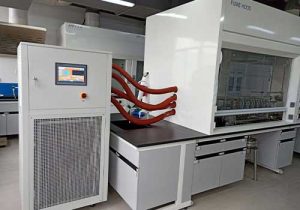cooling and heating equipment
Key Types of Cooling and Heating Equipment:
HVAC Systems: Centralized units for air conditioning and heating.
Heat Pumps: Provide both cooling and heating through refrigerant cycles.
Chillers: Cool liquids for industrial processes and large buildings.
Boilers & Furnaces: Generate heat through combustion or electric resistance.
Radiant Heating Systems: Use heated floors or panels for efficient warmth.

How They Work:
Cooling Equipment: Uses refrigerants to absorb and expel heat (e.g., air conditioners, chillers).
Heating Equipment: Generates warmth via combustion, electricity, or heat exchange (e.g., furnaces, heat pumps).
Applications:
Residential: Home climate control.
Commercial: Office buildings, hospitals, and retail spaces.
Industrial: Manufacturing, data centers, and food storage.
Energy Efficiency Considerations:
SEER (Seasonal Energy Efficiency Ratio) for cooling.
AFUE (Annual Fuel Utilization Efficiency) for heating.
Inverter technology and smart thermostats for optimized performance.
Proper selection, installation, and maintenance ensure longevity and efficiency.
Cooling and Heating Equipment: In-Depth Explanation
- Introduction to Cooling and Heating Equipment
Cooling and heating equipment encompasses a wide range of systems designed to maintain desired temperatures in various environments. These systems are essential for:
Human comfort (homes, offices).
Equipment operation (data centers, medical devices).
Industrial processes (manufacturing, food preservation).

- Types of Cooling Equipment
A. Air Conditioners
Window & Split ACs: Common in homes and small spaces.
Central Air Conditioning: Uses ductwork for whole-building cooling.
Variable Refrigerant Flow (VRF) Systems: Efficient for large commercial spaces.
B. Chillers
Air-Cooled Chillers: Use fans to dissipate heat.
Water-Cooled Chillers: More efficient but require cooling towers.
Applications: Industrial processes, hospitals, and data centers.
C. Evaporative Coolers
Use water evaporation to cool air (ideal for dry climates).
Energy-efficient but less effective in humid conditions.
- Types of Heating Equipment
A. Furnaces
Gas Furnaces: Burn natural gas or propane.
Electric Furnaces: Use heating coils; less efficient but cleaner.
Oil Furnaces: Common in areas without gas infrastructure.
B. Boilers
Heat water for radiators or underfloor heating.
Steam Boilers: Used in older systems.
Hot Water Boilers: More common in modern setups.
C. Heat Pumps
Air-Source Heat Pumps: Extract heat from outdoor air (efficient in mild climates).
Ground-Source (Geothermal) Heat Pumps: Use underground temperatures for higher efficiency.
D. Radiant Heating Systems
Hydronic (Water-Based): Pipes circulate warm water under floors.
Electric: Heating cables or mats for spot heating.
- Combined Cooling & Heating Systems
A. Heat Pumps (Reversible Systems)
Provide both cooling and heating by reversing the refrigerant cycle.
Types:
Ducted: Centralized systems.
Ductless Mini-Splits: Ideal for room-specific control.

B. Packaged HVAC Units
Combine heating and cooling in a single outdoor unit.
Common in commercial buildings.
- Key Components & How They Work
Cooling Equipment Operation:
Refrigerant absorbs heat from indoor air via the evaporator.
Compressor increases refrigerant pressure, raising its temperature.
Condenser releases heat outdoors (air-cooled) or to water (water-cooled).
Expansion valve reduces refrigerant pressure, cooling it before the cycle repeats.
Heating Equipment Operation:
Furnaces: Burn fuel to heat air, distributed via ducts.
Boilers: Heat water/steam, circulated through radiators or pipes.
Heat Pumps: Extract ambient heat (even in cold air) and amplify it.
- Applications of Cooling & Heating Equipment
A. Residential Use
Cooling: Split ACs, central air conditioning.
Heating: Furnaces, heat pumps, radiant floors.
B. Commercial Use
Office Buildings: VRF systems, rooftop HVAC units.
Hospitals: Precision cooling for labs and equipment.
C. Industrial Use
Manufacturing: Process cooling with chillers.
Data Centers: Mission-critical cooling to prevent overheating.
- Energy Efficiency & Environmental Impact
A. Efficiency Ratings
SEER (Cooling): Higher ratings = better efficiency.
AFUE (Heating): Measures furnace efficiency (90%+ is high).
HSPF (Heat Pumps): Heating efficiency rating.
B. Eco-Friendly Alternatives
R-32 Refrigerant: Lower global warming potential than R-410A.
Geothermal Systems: Use renewable ground heat.
Solar-Powered HVAC: Reduces grid dependency.
- Choosing the Right System
Consider:
Climate: Heat pumps work well in mild winters; furnaces better in extreme cold.
Space Requirements: Ductless vs. centralized systems.
Energy Costs: Electric vs. gas vs. renewable options.
Maintenance Needs: Filters, refrigerant checks, boiler servicing.
- Maintenance Tips
Cooling Systems:
Clean/replace filters monthly.
Check refrigerant levels annually.
Inspect condenser coils for debris.
Heating Systems:
Furnace filter replacement every 3 months.
Boiler pressure checks.
Heat pump defrost cycle inspection.
- Future Trends in Cooling & Heating
Smart Thermostats: AI-driven temperature optimization.
Magnetic Refrigeration: Emerging, energy-efficient cooling tech.
Hybrid Systems: Combining heat pumps with solar for zero-emission HVAC.
Conclusion
Cooling and heating equipment is vital for comfort, health, and industrial operations. Understanding the different types, efficiency metrics, and maintenance requirements helps users select the best system for their needs while minimizing energy consumption and environmental impact. Advances in technology continue to improve performance, making modern systems more sustainable and cost-effective.
Related recommendations
How long is the process chillers used for maintenance?
1061How long is the process chillers used for maintenance? The maintenance time of the process cooler depends on its operating environment, process requirements, and manufacturer's recommen...
View detailscooling water circulator
604Cooling Water Circulator: Precision Temperature Control for Industrial Applications Cooling water circulators are essential in maintaining optimal temperatures in a range of industrial and scie...
View detailsheater cooler unit
544Heater Cooler Units: Technology, Efficiency, and Impact on Indoor Air Quality Heater cooler units play a critical role in heating, ventilation, and air conditioning (HVAC) systems, enabling the...
View detailsWhat is the Role of Brine in Low Temperature Chillers?
1486What is the Role of Brine in Low Temperature Chillers? The brine solution has a lower condensation temperature, so it can be often used in medium-temperature and low-temperature chillers to ...
View details
 LNEYA Chiller
LNEYA Chiller







HelloPlease log in